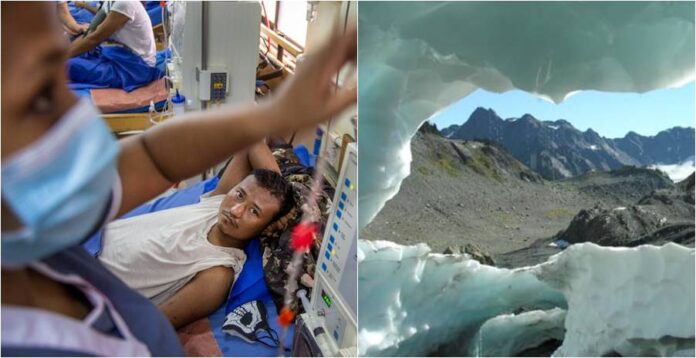Two headlines in the news today caught my attention. The first is the story about how the majority of alpine glaciers are expected to vanish by 2100 with only Greenland and Antarctica’s continental ice sheets the survivors.
The second story comes from Nepal and is not about the Himalayas’ glaciers, but rather about young Nepalese who leave the country for work and increasingly are coming home with chronic kidney disease from labouring in factories and farms in climate hot zones where temperatures are creating inhospitable conditions.
The Glacier Story
In the journal Science, a new research study describes findings that show ice loss from global glaciers amounting to between a quarter and a half of their total mass by 2100. The impact on sea levels and freshwater availability for 2 billion around the planet will be noticeable.
How does this study differ from past research reports on the impact of climate change on alpine glaciers? It suggests ice losses will be far more significant than previously measured. Using satellite imagery and remote data collection, the study gives a more accurate picture of the current and through modelling, the future state of the world’s 215,000 alpine glaciers.
If mean atmospheric temperatures rise 1.5 Celsius (2.7 Fahrenheit), the United Nations stated goal, the study predicts nearly half of existing glaciers could be gone by 2100. We are already topping a 1.1 Celsius (almost 2 Fahrenheit) rise from pre-Industrial Revolution atmospheric temperatures. Current climate modelling indicates we are on pace by 2100 to see a 2.1 to 2.9 Celsius (3.9 to 5.2 Fahrenheit) rise.
For the European Alps, South America’s Andes, the Rockies of Western North America, Central Asia’s Himalayas, the glaciers of Iceland, and South Island, New Zealand, by 2100 these landscapes will be far different.
Glaciers today lock up 75% of the planet’s freshwater. Glacier ice is second to the ocean, the largest reservoir of water on Earth. Most of the world’s longest rivers have alpine glacier sources that produce a continuous source of fresh water for consumption, as a habitat for fish and other wildlife, and serve to provide a reliable means of navigation for transportation. Although most of these rivers will continue to exist, as ice volumes decline the impact on water flow will be highly variable depending on consistent levels of precipitation.
Freshwater release from glaciers will impact ocean sea levels. The study forecasts a rise of 115 millimetres (4.5 inches) which doesn’t take into consideration ocean thermal expansion from rising temperatures, or changes in the behaviour of ocean currents that can exacerbate storm surges, strengthen hurricanes, and further disrupt coastal communities.
The Nepal Story
As reported in today’s Washington Post, young Nepalese who are leaving the country to find work in places like the United Arab Emirates, Saudi Arabia, Kuwait, Sri Lanka, Malaysia, and elsewhere are experiencing a rise in kidney disease linked to exposure to extreme heat. That’s because the heat scars and cripples the tubules within the organ. And as the world continues to warm, medical experts predict a significant rise in kidney problems for those labouring outdoors or in the unairconditioned factories of an increasingly hotter world.
A statement issued in April 2022 by the American Society of Nephrology stated that action was needed to “address the impact of climate change on the 850 million people, including more than 37 million Americans, living with kidney diseases across the world who are uniquely vulnerable to the effects of climate change.”
The statement linked kidney health to heat exposure in inhospitable climates noting a rise of 2.0 Celsius (3.6 Fahrenheit) will increase risk factors for acute kidney diseases. It further states that “the population of people with kidney diseases is disproportionately composed of people at socioeconomic disadvantage who are also bearing the greatest burden of climate change.”
The case of Nepal is a good example of this. about 10% of the nation’s population works abroad and mostly in the world’s hottest locations. This pattern of working abroad is resulting in Nepalese coming home with incurable diseases and contributing to a healthcare burden for families and the nation. In a 2021 Bournemouth University study, Nepalese nephrologists reported a link between working abroad and kidney diseases. One surgeon noted that a third of his patients requiring kidney transplants were young men coming back from global climate hotspots.
Kidney diseases leading to failure are often hard to detect at first. The decline in function can be asymptomatic for a long period and then suddenly the condition is irreversible requiring dialysis to survive, and ultimately, a transplant. The increased frequency of kidney failure led the Nepalese government in 2016 to begin offering dialysis treatment for free. But Nepalese migrant workers labouring in sauna-like conditions continue to come home sick. And new kidneys are getting hard to find with a black market emerging for organs.
Described as Nepal’s “open secret,” abnormal rates of kidney disease linked to heat exposure, will only get worse as global temperatures continue to rise making working outdoors in increasingly inhospitable parts of the planet a burden and threat to the migrant worker community.
The Washington Post article notes that 1,500 Nepalese, almost all men, continue to leave for work in Malaysia, Qatar and Saudi Arabia. Many will experience kidney failure and need transplants to survive.
And Nepal isn’t alone in facing the growing health burden when it sends its poorest to hot zones of the planet to work. Other countries that export labour to places like the Persian Gulf where climate change forecasts indicate an increasingly inhospitable future for outdoor work, will end up bearing the healthcare burden as well.









